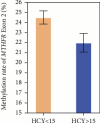Association Between DNA Methylation of MTHFR and Diabetic Kidney Disease
- PMID: 40697776
- PMCID: PMC12283192
- DOI: 10.1155/jdr/8096423
Association Between DNA Methylation of MTHFR and Diabetic Kidney Disease
Abstract
Objective: The objective of this study is to explore the association between MTHFR DNA methylation and diabetic kidney disease (DKD). Methods: This study involved 120 healthy people, 200 diabetes mellitus (DM) patients, and 200 DKD patients who visited China-Japan Friendship Hospital from 2022 to 2023. We selected four CpG islands for the detection of MTHFR DNA methylation: three located in the promoter region and one in Exon 2. The methylation rate of the MTHFR gene was measured using an enzyme digestion method combined with quantitative PCR. Clinical and biochemical characteristics between the two groups were also collected. Results: The methylation rate of the three CpG islands in the promoter region showed no significant differences between the DM and DKD patients. However, a significant difference in the CpG island methylation rate of the MTHFR gene Exon 2 was observed (25.14% vs. 21.94%, p < 0.001). Logistic regression analysis indicated that the methylation rate of MTHFR Exon2 is negatively associated with the occurrence and progression of DKD (OR = 0.947, 95% CI [0.919, 0.977], p = 0.001), with adjustments for gender, age, BMI, smoking, drinking, CHO, and TG. Significant differences were observed in the methylation ratios in different HCY groups (24.51% vs. 21.99%, p = 0.031). Linear regression showed MTHFR Exon 2 methylation negatively correlated with homocysteine (HCY) levels (p = 0.007). Conclusion: Methylation of the MTHFR gene Exon 2 is a protective factor for DKD and may contribute to its onset and progression through its influence on HCY levels. These findings highlight the potential of MTHFR methylation as a biomarker for DKD.
Keywords: DKD; DNA methylation; HCY; MTHFR.
Copyright © 2025 Guoxiong Deng et al. Journal of Diabetes Research published by John Wiley & Sons Ltd.
Conflict of interest statement
The authors declare no conflicts of interest.
Figures


References
-
- Magliano D. J., Boyko E. J., IDF Diabetes Atlas 10th Edition Scientific Committee . IDF Diabetes Atlas . International Diabetes Federation; 2021. - PubMed
MeSH terms
Substances
LinkOut - more resources
Full Text Sources
Medical
Miscellaneous

